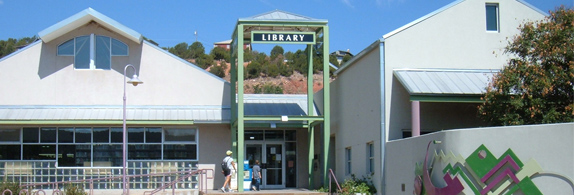
When Tijeras incorporated as a village in 1973, it had about 300 residents, a cement plant next door and a highway to Albuquerque, where most of its residents worked. Preparing to celebrate its 40th birthday Aug. 17, it has 546 residents, a cement plant next door and a highway to Albuquerque, where most of its residents work.
By this perspective, remarkably little has changed over the course of a generation. That continuity, however, represents a notable achievement, according to Mayor Gloria Chavez, the village’s longest-serving chief officer, because the whole purpose of incorporation “was to have a voice.”
The village has not wanted to pursue the Edgewood model of expansive annexation and tumultuous commercial growth. It has been cautious about adding land, homes and businesses to its municipal responsibilities. “We believe we need to serve our current residents well before adding new ones,” Chavez remarks during a lengthy interview in the village offices on N.M. 333. She continues: “We haven’t grown all that much but that’s by choice, not to have to put in the infrastructure. We’re having a hard enough time getting funding for the residents that we have now.”
If by the raw numbers of growth and population, little seems to have changed in the village, by other measures change has proceeded apace. Almost none of the commercial and government buildings that are prominent around the intersection of N.M. 333 and N.M. 337 existed in 1973. The senior center, the library, the Forest Service ranger station, the county public safety building, separate middle and elementary schools (they had been combined in one facility) Wells Fargo Bank, several small service businesses and even the current Post Office are all of relatively recent vintage.
Two old buildings that have survived and been rehabilitated are the old Post Office, which is now a visitors’ center, and the old Santa Niño Church (Tijeras Historical Church), which is now used by the East Mountain Historical Society to display old photographs.
A. Montoya school was there then, and so was the old post office. So was Molly’s bar. Interestingly, the town had three grocery stores 40 years ago; now it has none. Village Counselor Tina King, who was born in Tijeras, laments increased worry about crime, although the East Mountains is still an exceptionally safe area with little violent crime (police activities, with rare exceptions, involve traffic, loose dogs, burglaries and domestic disputes).
She fondly recalls the days when kids were free to roam at will through the mountains. Now, fear of crime and fencing of private property have confined many kids to such sedentary pursuits as video games and sexting. She laments the passing of the day when a single officer, the legendary Deputy Sheriff Tomas Herrera, so effectively patrolled the entire area that kids in trouble preferred to deal with him than with their own parents.
Another very visible law enforcement presence was municipal Judge Molly Simbfalla, whom King recalls as “a very short lady with a cane, but she ruled.”
But perhaps the biggest change is something the public hardly notices: bridges. “Back in those days we had no bridges and we got a lot of rain,” Chavez says. “Whichever side you were on you were stuck there.” Today, all the arroyos are spanned by bridges, and they are sturdy enough to withstand even the kind of torrential storms that have lashed the East Mountains in recent weeks.
Over its 40 years, the village has had remarkable political stability, with only four mayors (the same number Edgewood has had in a mere 14 years). Chavez has already served 13 years; her term doesn’t expire until 2016, and she seems inclined to run for another term then. Chavez is a native of the North Valley who moved to Tijeras in 1972, but she recalls spending a lot of time in the village even as a child because her father and her future father-in law, a village resident, were fast friends
King, along with some other residents, credits Chavez for the village’s notable success in attracting state and, above all, federal money for infrastructure, including not only bridges but water and sewer lines, roads and public buildings—all things the tiny and not especially wealthy village could hardly have financed on its own.
That success has given the village a presence disproportionate to its size. “We’re a small community,” the mayor says, “but our voice is being heard throughout the state and the nation.”
But the village has not gotten everything it sought. For some time it has unsuccessfully petitioned the state to redo the north branch of the interstate ramp where it intersects N.M. 333 in front of Molly’s bar. Chavez feels the intersection is dangerous because it requires traffic to cross a couple of lanes. In addition, “we’re trying to make Tijeras more pedestrian friendly, and you can walk to that point but then it’s dangerous.”
Some have been critical of the mayor for resisting changes they would like to see happen. When a project to incorporate North 14 as East Mountain Villages collapsed, its advocates placed some of the blame on the Tijeras government, although Chavez now says she was neither for nor against the new incorporation. Several communities near Tijeras have wanted to be annexed into the village, but Chavez and other village officials are leery of adding land that would cost the village more to serve than it would contribute in tax revenue. Some proposed public projects, notably a county swimming pool, have failed to get off the ground. And traffic generated by the Tijeras Arts Market has been a repeated subject of dissension.
Just like 40 years ago, only a minority of residents are employed locally. King recalls that what is now GCC Rio Grande Portland Cement—which opened in 1959 and was bought by a Mexican company in 1994—was the single biggest local employer in the 1970s but, with the collapse of area construction, now employs only two residents. The plant also usually made generous annual donations to local activities but has not done so since the recession, Chavez said.
The continuing Great Recession has put a crimp in village infrastructure development, slashed its income, hurt local businesses, curtailed employment and forced painful municipal choices, for example cutting back services at the new senior center and closing the Motor Vehicle Division office that issued driver’s licenses and car registrations. The population today is a bit less than it was in 1940.
Chavez said the prolonged recession has been an unprecedented setback, unlike anything the village has ever witnessed before. But now she sees the first hints of an economic turnaround and believes the future, based on the village’s key geographical local as the “gateway to the East Mountains,” will be more prosperous than the recent past.
Asked what she thinks the village will be like in 40 years, Chavez looks stunned. Finally she responds, “I couldn’t have foreseen the way things have gone the past 40 years, and I can’t begin to predict the next 40. I’ll just be watching it from heaven.”
She has made it a trademark of her by-and-large successful administration to speed slowly into the future, but she is also realistic about how time has altered the Tijeras area. “People say let’s stay rural, but they don’t know rural. It’s not rural anymore.” Judging by her repeated re-election, most Tijeras residents seem to like the balance the village has struck between change and continuity.



Responses to “Tijeras: 40 years of speeding slowly into the future”